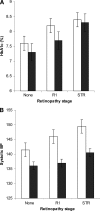Higher prevalence of retinopathy in diabetic patients of South Asian ethnicity compared with white Europeans in the community: a cross-sectional study
- PMID: 19074992
- PMCID: PMC2646018
- DOI: 10.2337/dc08-1422
Higher prevalence of retinopathy in diabetic patients of South Asian ethnicity compared with white Europeans in the community: a cross-sectional study
Abstract
Objective: The purpose of this study was to compare prevalence and risk factors for diabetic retinopathy among U.K. residents of South Asian or white European ethnicity.
Research design and methods: This was a community-based cross-sectional study involving 10 general practices; 1,035 patients with type 2 diabetes were studied: 421 of South Asian and 614 of white European ethnicity. Diabetic retinopathy, sight-threatening retinopathy, maculopathy, and previous laser photocoagulation therapy were assessed after grading of retinal photographs. Data were collected on risk factors including age, duration, and treatment of diabetes, blood pressures, serum total cholesterol, and A1C.
Results: Patients of South Asian ethnicity had significantly higher systolic (144 vs. 137 mmHg, P < 0.0001) and diastolic (84 vs. 74 mmHg, P < 0.0001) blood pressure, A1C (7.9 vs. 7.5%, P < 0.0001), and total cholesterol (4.5 vs. 4.2 mmol/l, P < 0.0001). Diabetic retinopathy was detected in 414 (40%) patients (189 South Asian [45%] versus 225 white European [37%]; P = 0.0078). Sight-threatening retinopathy was detected in 142 (14%) patients (68 South Asian [16%] versus 74 white European [12%]; P = 0.0597). After adjustment for confounders, there were significantly elevated risks of any retinopathy and maculopathy for South Asian versus white European patients.
Conclusions: Patients of South Asian ethnicity had a significantly higher prevalence of diabetic retinopathy and maculopathy, with significantly elevated systolic and diastolic blood pressure, A1C, and total cholesterol; lower attained age; and younger age at diagnosis. Earlier onset of disease and higher levels of modifiable risk factors make early detection of diabetes, annual referral for retinal screening, and intensive risk factor control key elements in addressing this health inequality.
Figures
References
-
- Zimmet PZ, McCarty D, de Courten MP: The global epidemiology of non-insulin dependent diabetes mellitus and the metabolic syndrome. J Diabetes Complications 11:60–68, 1997 - PubMed
-
- Stratton IM, Kohner EM, Aldington SJ, Turner RC, Holman RR, Manley SE, Matthews DR, for the IKPDS Group: UKPDS 50: Risk factors for incidence and progression of retinopathy in type II diabetes over 6 years from diagnosis. Diabetologia 44:156–163, 2001 - PubMed
-
- Barnett AH, Dixon AN, Bellary S, Hanif MW, O'Hare JP, Raymond NT, Kumar S: Type 2 diabetes and cardiovascular risk in the UK South Asian community. Diabetologia 49:2234–2246, 2006 - PubMed
-
- Hayward LM, Burden ML, Burden AC, Blackledge H, Raymond NT, Botha JL, Karwatowski WSS, Duke T, Chang YF: What is the prevalence of visual impairment in the general and diabetic populations: are there ethnic and sex differences? Diabet Med 19:27–34, 2002 - PubMed
Publication types
MeSH terms
Substances
LinkOut - more resources
Full Text Sources
Medical


